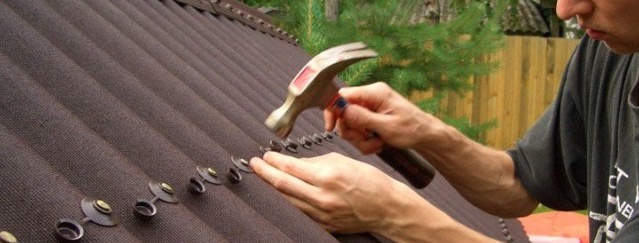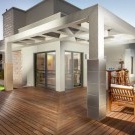Advantages and disadvantages of ondulin
Ondulin production involves the use of the latest technology. It consists of 4 main components: thermosetting resin, mineral fillers, cellulose fiber. The material is impregnated in several stages with bitumen in vacuum chambers. Due to this, the material has high waterproofing. After impregnation, the sheets are stained. In appearance and color, the ondulin is divided into:
- matte painted with acrylic paint; it is rough to the touch;
- glossy the most smooth and bright, this is achieved by adding silicone to the paint used.
Advantages of ondulin:
- the service life is about 50 years, of which 15 years are a guaranteed period of absolute water resistance;
- since the material does not contain asbestos, it is considered environmentally friendly;
- having a small weight, ondulin provides a minimum load on the rafters;
- perfectly copes with environmental factors;
- if the installation is performed according to all technical standards, then the roof is able to withstand large volumes of snow and gale-force wind;
- ondulin can also be used in various economic fields, for example, it can be used for facing a vertical surface;
- Due to its light weight and simple cutting, the installation process is much easier than using alternative roofing materials.
Disadvantages of ondulin:
- small color scheme;
- the color of the roof begins to fade over time;
- the material “floats” under the strong influence of sunlight, in very hot weather, ondulin can “creep” underfoot;
- low fire safety, the material is significantly inferior to its close competitor - metal;
- with a small angle of inclination, there is a chance of water flowing into the locks;
- collects dust.
Ondulin sheet has a small weight, which greatly facilitates installation. It is resistant to various atmospheric effects, to the aggressive effects of acids and alkalis, etc. The material also has resistance to mold, bacteria and various types of fungi. Ondulin has a low cost, which makes it very affordable.
In addition to the advantages, like any roofing material, ondulin has some disadvantages. Since the basis of ondulin contains organic components, it is combustible. In production, this fact is taken into account and the material is coated with special compositions that significantly reduce this indicator. If the roof is operated correctly, then such troubles, as a rule, do not arise. Under the influence of ultraviolet radiation, ondulin may lose its original color brightness.
Since opaque ondulin on its rough surface traps dust and fine litter, periodic cleaning is required. As for the glossy ondulin, it should be noted that an avalanche-like descent of snow from the slopes is possible. In this regard, it is necessary to take measures for the installation of snow retainers.
So the ondudine sheet has a large size; it is used for a roof having a simple structure. For other uses, a soft ondulin tile is suitable. Ondulin is very convenient and easy to install the roof. Despite small flaws, he successfully established himself as a universal material.
Consider an example of mounting a roof using ondulin on video



